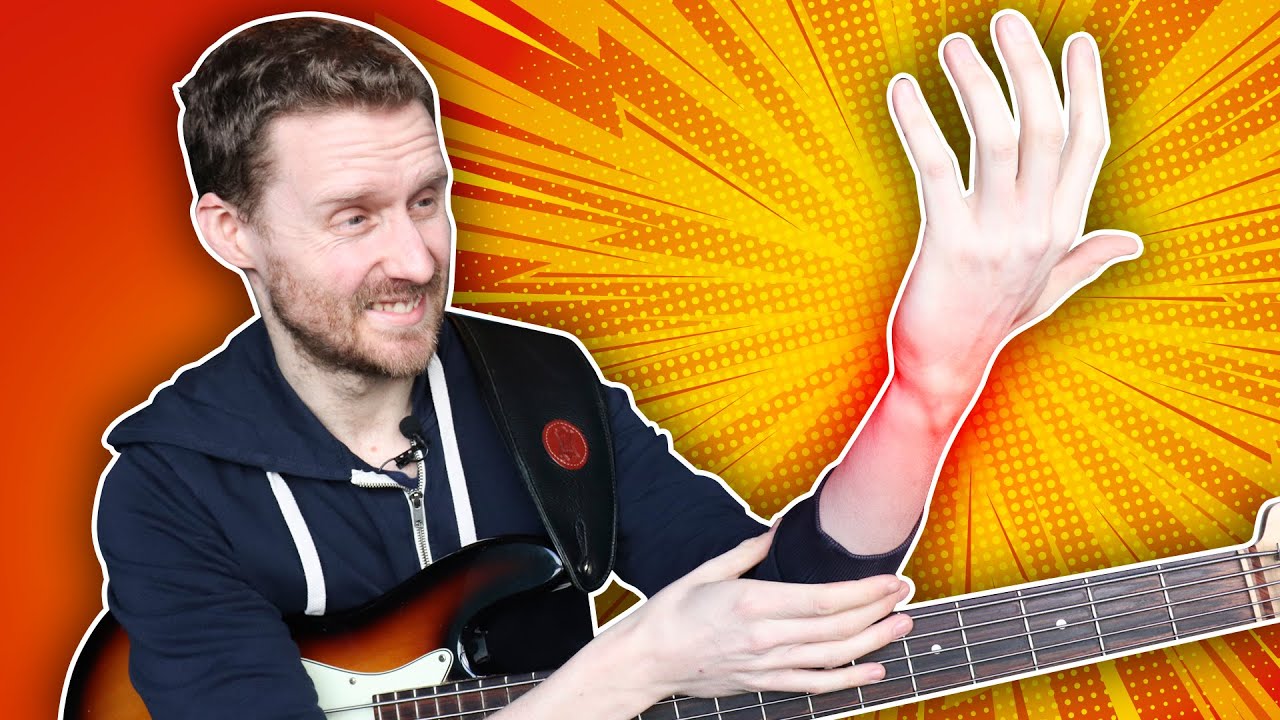If your bass fretting hand hurts when you play then that’s a serious sign that something is wrong with your technique.
I talked about this before in this video 5 Things I Wish I Knew As A Beginner Bassist…
But fretting-hand wrist pain is a topic that’s so important it needs its own video.
We will talk about cures in a moment but before we do, it’s important to talk about causes.
Why?
Simply put. You don’t want wrist pain to become a recurring problem. And the best way to avoid it in the future is to become conscious of what you’re doing wrong in the present and correct your technique as soon as possible.
After all, you can’t change what you’re not conscious of.
Makes sense.
So what does cause fretting hand pain for bass players?
A hurt bass fretting hand is usually either caused by excess muscle tension, bad technique, bent wrists or bad posture. Good treatments include massages, Alexander technique or speaking to a specialist doctor.
For more information, watch the video below.
Causes Of Fretting Hand Pain
1. Bent Wrists
Our wrists are not designed to stay bent for long periods of time. And they are really not designed to carry out complicated tasks like playing the bass guitar when they are bent.
Record yourself playing and watch for the wrist angles you have when you play. Ideally, they should be as flat as possible.
2. Bad Posture
Bad bass playing posture, such as wrong strap height or sitting badly, can create pain in the elbows, under the thumb or anywhere along the arm.
Again, film yourself playing and make sure you’re not hunched over the bass and pushing limbs out of they’re natural position.
3. Muscle Tension
Whilst we can’t eliminate tension we must try to minimize it at all costs.
Why?
Well, the tenser we are when we play, the less muscle power we have at our disposal and the harder it becomes to move naturally.
What can be done to minimize this?
Try to keep your hands in as natural a position as you can. This way, they can’t be tense because being in a natural position means using little muscle power.
So, we’ve understood how the fretting hand starts to hurt and we know what to avoid. But, what should you do about it now we’re in pain?
What should you do differently?
1. Take a break!
Never play through the pain. Ever.
There’s a certain romance that comes from “pushing through” but this kind of false heroism will just land you back in the injury room.
If your body is in pain, then it’s telling you something is wrong and that it needs a break.
You should always listen!
Possible Treatments For Fretting Hand Pain
2. Stretch
Stretching will help release tension in the muscles but there’s a caveat here.
Not all stretches will be relevant to your problem. And, pain experienced in one area of the body – the hand for example – can be a symptom of a problem elsewhere in the body.
Without a proper diagnosis, you have no idea if you have tight muscles, carpal tunnel, an elbow problem or something else.
This is why you must find stretches that are relevant to you. But what I will say is that the right stretches can really help.
Particularly if you spend a lot of your playing time doing things like walking bass where your fretting hand is outstretched in lower areas of the neck with bigger stretches.
How do you do that?
3. Speak To A Specialist/Doctor
A specialist will be able to give you really specific advice on how to stretch before playing, how to alter your posture and how you can play more safely.
I recommend Jennie Morton who is an excellent consultant who is used to dealing with performers of all types.
4. Get A Massage
I’ve benefitted from several deep tissue massages. Our muscles can become tight if we’re using them a lot and, whilst stretching is always a great thing to do, sometimes it’s not enough.
Also, whether we play the bass with fingerstyle technique, pick technique, slap technique or any other technique, muscle tension is simply a part of playing so having a good massage can help balance this out.
A good deep tissue or sports massage can help work out a lot of the tension your body is holding on to.
5. Learn About Posture
Lastly, it’s great to learn about how to use your body more effectively.
I had to do this as part of my recovery program and it changed everything for the better.
Trust me when I say that whether you play slap bass, play with fingerstyle technique, or favor pick technique, learning about posture will help you out every day that you play the bass.
I learned about Alexander technique from an instructor called Jane Gregory.
Caveat!
I always encourage you to speak to a qualified medical specialist. I’m not offering medical advice here. I’m just sharing my own experience with injury and my teaching experience of having seen how others pick up injuries.
This post is not designed to be a complete picture of all the knowledge on this subject. Just a useful (I hope) account of my own experiences.
If you’re in doubt, speak to a medical professional.
I’d strongly recommend the ones listed above.


Leave a Reply